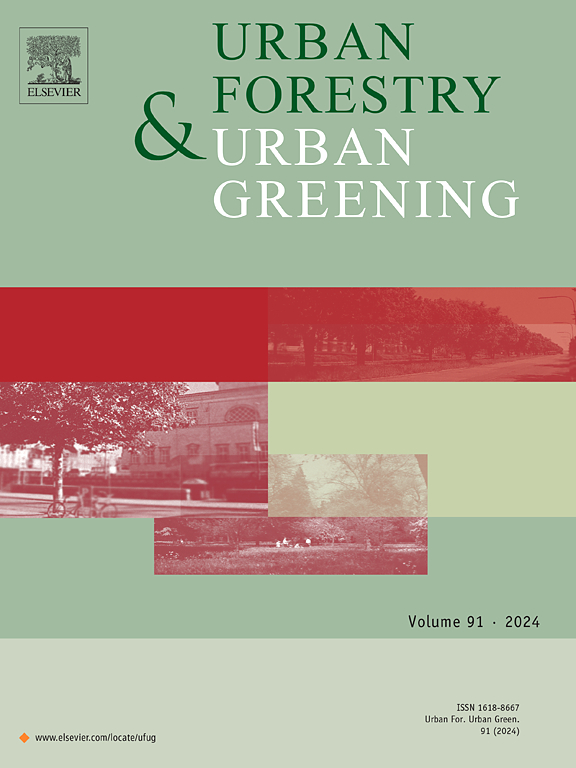Multi-level barriers and opportunities for urban greening and depaving initiatives as climate change adaptation measures: Quebec City case study
IF 6
2区 环境科学与生态学
Q1 ENVIRONMENTAL STUDIES
引用次数: 0
Abstract
Urban greening and depaving initiatives are increasingly recognized as climate change adaptation strategies in cities worldwide. However, several individual and institutional barriers, including social acceptability, can hinder the successful implementation of these initiatives. This study aims to understand the decision-making processes and citizen perceptions associated with urban greening and depaving initiatives in Quebec City. Using a mixed-methods approach, we conducted detailed interviews with 18 stakeholders and a questionnaire-based survey of 770 residents in the city. Our findings show that these initiatives could be characterized into five project types, comprising community-supported projects and projects led by different city departments, including engineering, urban planning, and mobility, with smaller contributions from departments such as recreation park services. While a horizontal structure between these departments fostered collaboration, a top-down approach to the decision-making process limited the implementation of such initiatives. In addition, economic, technical, and organizational barriers were limiting factors, particularly the perceived lack of citizen support for these initiatives. Nevertheless, the survey results revealed strong support from citizens, with more than 80 % of participants expressing moderate to high levels of support. In addition, while nearly half of the survey participants (47 %) identified private car use as their preferred mode of transport, the participants showed a willingness to reduce parking spaces to support depaving initiatives. To overcome the barriers to and promote the successful implementation of urban greening and depaving initiatives, greater collaboration between decisionmakers, professionals, and the community in Quebec City is needed. Our results have significant implications for advancing such initiatives beyond Quebec City. By examining stakeholders’ perceptions, our findings can inform decision-making processes and promote the adoption of public policies to support these initiatives in city planning agendas.
作为气候变化适应措施的城市绿化和绿化举措的多层次障碍和机遇:魁北克市案例研究
在世界范围内,城市绿化和绿化作为适应气候变化的战略日益受到重视。然而,一些个人和体制障碍,包括社会可接受性,可能阻碍这些倡议的成功实施。本研究旨在了解魁北克市与城市绿化和绿化倡议相关的决策过程和公民观念。采用混合方法,我们对18名利益相关者进行了详细的访谈,并对770名城市居民进行了问卷调查。我们的研究结果表明,这些举措可以分为五种项目类型,包括社区支持的项目和由不同城市部门(包括工程、城市规划和交通)领导的项目,其中娱乐公园服务等部门的贡献较小。虽然这些部门之间的横向结构促进了协作,但自上而下的决策过程方法限制了这些倡议的实施。此外,经济、技术和组织障碍是限制因素,特别是缺乏公民对这些倡议的支持。尽管如此,调查结果显示市民的强烈支持,超过80% %的参与者表示中高水平的支持。此外,虽然近一半的受访者(47% %)认为私家车是他们的首选交通工具,但他们也表示愿意减少停车位,以支持减少车道的措施。为了克服障碍,促进城市绿化和绿化计划的成功实施,魁北克市的决策者、专业人士和社区之间需要更大的合作。我们的结果对推动魁北克市以外的此类举措具有重要意义。通过研究利益相关者的看法,我们的研究结果可以为决策过程提供信息,并促进公共政策的采用,以支持城市规划议程中的这些举措。
本文章由计算机程序翻译,如有差异,请以英文原文为准。
求助全文
约1分钟内获得全文
求助全文
来源期刊

Urban Forestry & Urban Greening
FORESTRY-
CiteScore
11.70
自引率
12.50%
发文量
289
审稿时长
70 days
期刊介绍:
Urban Forestry and Urban Greening is a refereed, international journal aimed at presenting high-quality research with urban and peri-urban woody and non-woody vegetation and its use, planning, design, establishment and management as its main topics. Urban Forestry and Urban Greening concentrates on all tree-dominated (as joint together in the urban forest) as well as other green resources in and around urban areas, such as woodlands, public and private urban parks and gardens, urban nature areas, street tree and square plantations, botanical gardens and cemeteries.
The journal welcomes basic and applied research papers, as well as review papers and short communications. Contributions should focus on one or more of the following aspects:
-Form and functions of urban forests and other vegetation, including aspects of urban ecology.
-Policy-making, planning and design related to urban forests and other vegetation.
-Selection and establishment of tree resources and other vegetation for urban environments.
-Management of urban forests and other vegetation.
Original contributions of a high academic standard are invited from a wide range of disciplines and fields, including forestry, biology, horticulture, arboriculture, landscape ecology, pathology, soil science, hydrology, landscape architecture, landscape planning, urban planning and design, economics, sociology, environmental psychology, public health, and education.
 求助内容:
求助内容: 应助结果提醒方式:
应助结果提醒方式:


